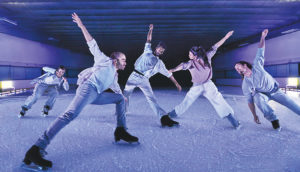Montreal: Fall 2018 - Vancouver Ballet Society
- Home
- City Reports 2015 - 2019
- Montreal: Fall 2018

By Victor Swoboda
Some of the most accomplished choreography in Montreal’s spring season occurred in forums not normally associated with dance.
Montreal-based avant-garde ice-dance troupe Le Patin Libre has achieved the status of high art in Europe, where it regularly tours. Bravo, therefore, to Montreal producer Pierre Desmarais for putting Le Patin Libre in his prestigious Danse Danse series. Desmarais hung elegant black curtains and added sophisticated lighting and sound to give a bland local hockey arena the feel of a real theatre.
Le Patin Libre’s shows over the years have grown in artistic conception and execution, and its latest, Threshold, reached new heights, thanks in part to dramaturg Ruth Little and lighting designer Lucy Carter, who have worked with Wayne McGregor and Akram Khan. The interweaving of skaters in ensemble patterns unfolded in complex, unexpected entrances and exits. Changes of rhythm were markedly exciting. In one mesmerizing sequence, skaters standing in a staggered line moved slowly backward or forward with only a slight tilt of their torsos, making a delightful illusion of people moving on air. If dance is, in part, an exploration of time and space, Threshold was a constant voyage of discovery.
Elsewhere, juggler Philippe Dupuis performed a masterfully choreographed solo, launching and catching plastic balls in handheld metal pails with unbelievable dexterity, pirouetting even as multiple balls fell from the air. At one point, he mounted an incline at the back of Tohu’s stage in the round, threw a bucketful of balls into the air, and a cohort of buckets popped up behind the incline and caught the balls in a wide swoop. It was marvellous theatre. Dupuis appeared in Sapience, a show directed by Anthony Venisse for new graduates of Montreal’s National Circus School. Venisse received his early training at l’école Rudra-Béjart Lausanne. The National Circus School’s director of creation, choreographer Howard Richard, has introduced strong elements of dance into the curriculum.
Equally delightful was the multiple hula-hoop twirling of William Jutras from a fledgling Montreal circus troupe called Le Monastère. Presenting an image of a peeved snob impatient with the world, Jutras twirled golden hoops around his body with astonishing rapidity, maintaining his stage character even while executing complex moves with aplomb.
Those who question whether acts like Le Patin Libre, Dupuis and Jutras can be categorized and judged seriously as dance should only recall the example of Fred Astaire. For years, Astaire was considered a mere entertainer until George Balanchine publicly declared his admiration for Astaire as one of the great artists of the 20th century. Montreal audiences have been generously receptive toward extending the parameters of what is considered dance.
Undoubtedly a highlight of the season came in the 2018 Festival Trans-Amériques with Betroffenheit, a 2015 collaboration between choreographer Crystal Pite for her Kidd Pivot company and actor Jonathon Young of Electric Company Theatre. In previous works, Pite has explored grief and mourning with impressive depth and feeling. With sustained brilliance over a 100-minute work in two acts, Betroffenheit looked at the complex therapeutic process involved in recovering from grief and loss.
As the central protagonist, Young entered into verbal dialogues in a terse Samuel-Beckett-like style, or danced with several figures who toiled diligently to keep him in a mourning state, represented visually by the walls of a room and by a wooden box large enough for Young to enter.
Pite and Young had the great insight to show how seductive the mourning state can be. Some people in mourning find perverse pleasure in prolonging their grief or in returning to it the moment they begin to recover. In Betroffenheit, this perverse pleasure was flamboyantly represented by “the show,” in which the protagonist acted as a garishly dressed master of ceremonies who introduced captivating tap and salsa dance numbers. In this context, the undeniably entertaining popular-dance rhythms took on a dark side, enticing the protagonist back into mourning.
The work ended with the astonishingly fluid Jermaine Spivey performing a long solo in which arms and legs struggled to find a co-ordinated harmony. Throughout Betroffenheit, Spivey had served as Young’s alter ego. As lights dimmed, Spivey walked slowly off largely in control of his limbs, which suggested hope of recovery. Pite does not tolerate trite solutions to the choreographic problems that she sets up, which is why she is among Canada’s most profound choreographers.
Danse Danse also presented the 11-year-old Quebec City-based troupe, Alan Lake Factori(e) in Lake’s Le cri des méduses, inspired by Raft of the Medusa, Théodore Géricault’s famous 1819 painting of shipwreck survivors. The set, lighting and mass formations of the nine dancers did indeed at times evoke visions of Géricault’s horrible scene. Visually, the scenes certainly had punch. Choreographically, however, the symbolic drama remained undeveloped, implying little more than that people are sufferers lost at sea.

Photo: Rolline Laporte
